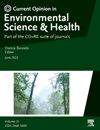新兴关注的生物传感污染物:新兴污染物检测的技术飞跃
IF 6.6
Q1 ENVIRONMENTAL SCIENCES
Current Opinion in Environmental Science and Health
Pub Date : 2025-07-28
DOI:10.1016/j.coesh.2025.100649
引用次数: 0
摘要
生物传感技术作为一种有效的、敏感的、高选择性的技术已经出现,用于识别水基质中出现的污染物(CECs)。这类污染物的大量含量对人类健康和生态系统极为有害,即使浓度极低。基于酶的生物传感技术利用酶的特异性和催化活性选择性地与污染物相互作用,产生可测量的信号进行检测和量化。在这里,我们总结了不同的酶驱动技术检测CECs。基于酶的传感器的使用代表了一种有前途的、可持续的方法来解决检测水基质中CECs的全球挑战。本文章由计算机程序翻译,如有差异,请以英文原文为准。
Biosensing contaminants of emerging concerns: A technological leap in emerging contaminant detection
Biosensing techniques have been emerging as potent, sensitive, and highly selective techniques to identify contaminants of emerging concern (CECs) in water matrices. The significant levels of these classes of pollutants are extremely detrimental to human health and ecosystems even at trace concentrations. Enzyme-based biosensing techniques utilize the specificity and catalytic activity of enzymes to selectively interact with pollutants, producing measurable signals for their detection and quantification. Here, we summarize different enzyme-driven techniques for the detection of CECs. The use of enzyme-based sensors represents a promising, sustainable approach to address the global challenge of detecting CECs in water matrices.
求助全文
通过发布文献求助,成功后即可免费获取论文全文。
去求助
来源期刊

Current Opinion in Environmental Science and Health
Medicine-Public Health, Environmental and Occupational Health
CiteScore
14.90
自引率
0.00%
发文量
92
审稿时长
114 days
 求助内容:
求助内容: 应助结果提醒方式:
应助结果提醒方式:


